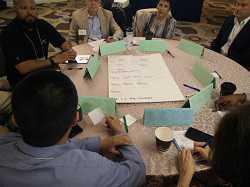Scenario Planning is a process to identify alternative futures based on trends and drivers of change. Used when there are unknown variables, participants can detect plausible futures and from there, select desired futures, goals and activities to get there.
Benefits & Problems Addressed
Working with uncertainty: Where impacts from change drivers such as technology or climate change are unknown, scenario planning helps participants understand and better prepare for a range of outcomes.
Mitigate risk: Participants can identify how negative scenarios unfold and critical decision points where action can prevent or mitigate impacts. In this way communities are evaluating success not only on an ultimate outcome, but more importantly, intervening decisions and actions
Education and engagement: Scenario planning sessions accomplish several engagement objectives in one session: education, input on tradeoffs, preferences, and if structured to do so, action steps.
Interdependencies: Sketching scenarios requires looking at ripple effects across disciplines, and thus break down siloes. This can help improve current process, not some uncertain future.
Tips & Techniques
Getting started: There are two approaches to scenario planning: (1) software programs and (2) process. Various software packages allow participants to alter a complex array of inputs in order to trace possible outcomes. Scenario planning as a process assembles a range of participants
Audiences: Once reserved for technical audiences, scenario planning can be used with the public to (1) gather questions and (2) communicate unknowns, scenarios and preferences. Agencies can conduct scenario planning with professionals to assess potential threats and opportunities (within and across Departments).
Drivers of Change: Communities need to begin by honing in on the most impactful drivers of change. This can be disruptive technology, climate change, and/or fiscal drivers (e.g., loss of large employer).
Typical Process: A typical process will require (1) researching trends and activity in the local area/region/state; (2) identifying key stakeholders who have knowledge of change drivers and how to implement action steps related to preferred scenarios; (3) identifying an end product; (4) designing workshops to assess trends, risks/benefits associated with trends, possible/probable/preferred scenarios, and (5) follow up on action items.
Charting positive and negative possibilities: One method of scenario planning structures a range of positive and negative alternative futures, selecting variables most influential in shaping the future (e.g. jobs, housing, mobility metrics). From there, communities can pick policy levers available to address affordable housing, social equity, transportation options and climate impacts such as heat.
Software vs. Process: The two methods of scenario planning can offer two levels of quantitative rigor. Instead of competing, communities should define the appropriate use in the overall scenario planning process.
Hot Buttons: Effective scenario planning requires overcoming several areas of bias (overconfidence, underestimating worst case scenarios, excluding key stakeholders). In addition, participants that feel threatened may refuse to participate. Participants may disagree over the degree of rigor needed. Whether or not scenario planning is effective for strategic management may not be known until an adverse event.
Resources
Consortium for Scenario Planning http://www.scenarioplanning.io.
Scenario Planning Applications Network: various curricula http://www.scenarioplanning.io/curriculum-material-library/
An Evaluation Framework for the Use of Scenarios in Urban Planning: Lincoln Institute of Land Policy https://www.lincolninst.edu/publications/working-papers/evaluation-framework-use-scenarios-urban-planning
Examples from Marketplace Partners
Scenario Planning Workshops for Planners: Nisenson Consulting LLC develops scenario planning workshops to help participants understand the status of smart city technology, create possible and probable scenarios, and identify next steps for their own organizations.

